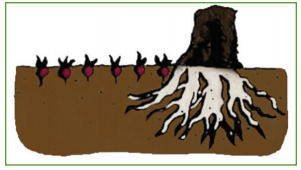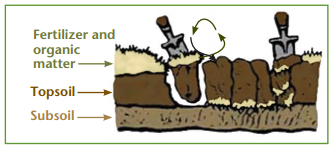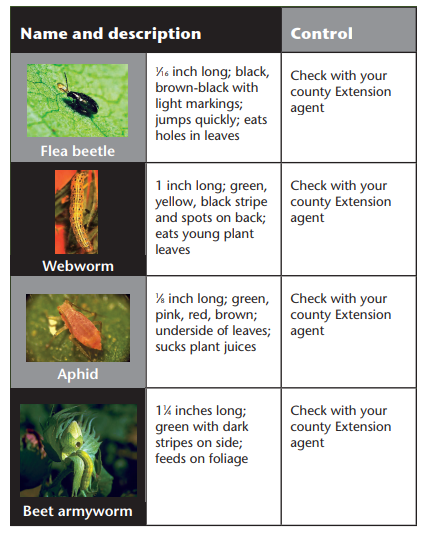Beets
By: Joseph Masabni

Beets are a cool-season crop and grow well in the cool temperatures of spring and fall. They do poorly in hot weather. Beets are well suited to large or small home gardens since they require little room. They are grown for both the roots which usually are pickled and the young tops which are used as greens. About 10 feet of row per person will provide enough beets to use fresh or for canning.

Where to plant beets
Beets can be planted in partial shade and grow best in deep, well-drained soils. Beets have deep roots that can reach depths of 36 to 48 inches, so do not plant them where tree roots will compete (Fig. 1).
Soil preparation
Before planting beets, make sure the soil is free of rocks, trash and large sticks. Mix fine pieces of plant material such as grass, leaves and small sticks into the soil to enrich it. Spade the soil 8 to 10 inches deep (Fig. 2). Be sure all plant material is covered with soil so it will break down quickly.

Beets do best in sandy soil in the spring and heavier soil in the fall because sandy soil warms faster than heavier clay soil. They do not grow well in tight clay. In poorly drained areas, make ridges 4 to 6 inches tall to allow water to drain (Fig. 3). The soil should have adequate organic matter to prevent it from crusting because crusty soil causes beet roots to be tough.
Beets are also sensitive to soils deficient in boron. Have your soil tested or ask your county Extension agent about boron deficiencies in your area.
Beet varieties
Beets are grown for both the root and top. The tops of any variety can be used for greens when prepared properly.
Some beet varieties are:

- Chioggia
- Detroit Dark Red
- Pacemaker II
- Red Ace
- Ruby Queen
Planting
Beets can be grown all winter in many South Texas areas. Farther north they should be planted as soon as the soil can be worked in spring. Soil temperature must be at least 40F for beet seeds to sprout.

Using a hoe handle, stick or similar object, make a furrow ½ inch deep down the center of the ridge (Fig. 4). Each beet seed produces 2 to 6 plants. Space the seeds 1 to 2 inches apart in the row. Cover seeds lightly with loose soil and sprinkle with water. Use seed treated with a fungicide to prevent the young plants from rotting. Plants should be up in 7 to 14 days. In hot weather, cover seed with sand or light-colored mulch.
For continuous supply of beets, make several plantings 3 weeks apart.
Fertilizing
Scatter 1 cup of a complete fertilizer such as 10-20-10 for each 10 feet of row. If the garden soil has a lot of clay, add compost. Mix the fertilizer 4 inches into the soil with a rake and work into beds as shown in Figure 2. Scatter 1 tablespoon of fertilizer for each 10 feet of row beside the plants when they are 4 to 6 inches tall.
Watering
Water the plants well weekly if it does not rain. Beet root systems can reach 36 inches or more if adequate soil moisture is available.
Care during the season
Keep the beet plants free of weeds which use nutrients and moisture. Scratch the soil next to the plants with a rake or hand tool to prevent crusting. Do not work the soil more than 1 inch deep or the root systems may be injured. Begin thinning the beets as soon as they get crowded in the row. Young tops make excellent greens. After thinning, the plants should be 2 to 3 inches apart.
Harvesting
Beets should be ready to harvest 7 to 8 weeks after they are planted.
Young, tender tops often have a mild quality, but the greens can be used until they get large and strong flavored. Young plants can be cooked with the root and top together, or you can use the root alone when it is the size of a golf ball or larger.
Pull the plants and cut off the root. If the tops are to be used, wash and place them in plastic bags in the refrigerator for 1 or 2 days. Roots will keep 1 to 2 weeks in plastic bags in the refrigerator.
If all the beets are not used, pull them and place in a compost pile or spade them into the soil.
Pesticides

Many insecticides are available at garden centers for homeowner use. Sevin® is a synthetic insecticide, while Bt-based insecticides and sulfur are organic options. Sulfur also has fungicidal properties and helps control many diseases. Before using a pesticide, read the label and always follow cautions, warnings and directions.
Diseases
Diseases on beets are most severe in cloudy, damp weather. Check plants daily and treat them with an approved fungicide if diseases appear. Neem oil, sulfur, and other fungicides are available for use. Always follow label directions.
Serving
Beets can be served fresh, or they can be preserved plain or pickled. Beet roots contain small amounts of vitamins and minerals, while beet greens are an excellent source of Vitamin A and calcium.
Download a printer-friendly version of this publication: Beets
Download this publication in Spanish: Cómo cultivar remolacha
